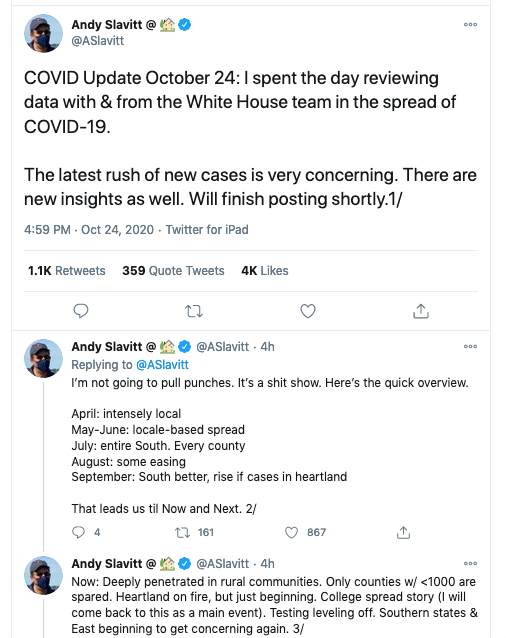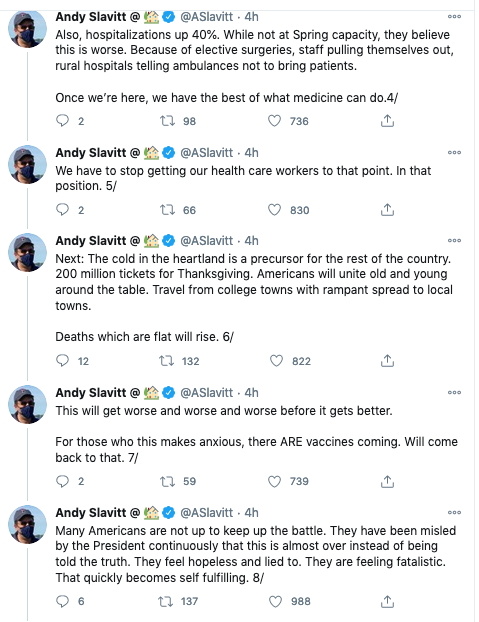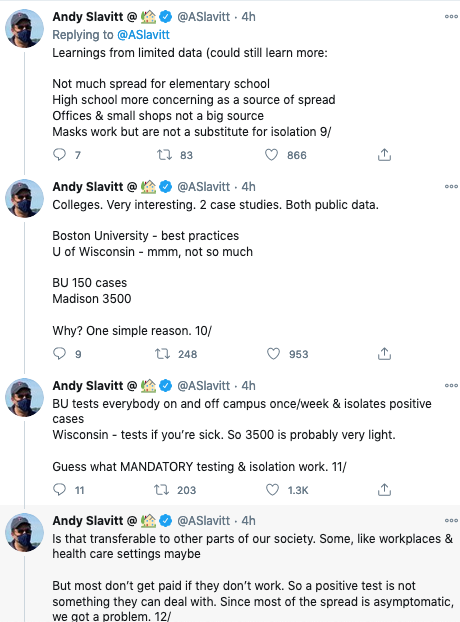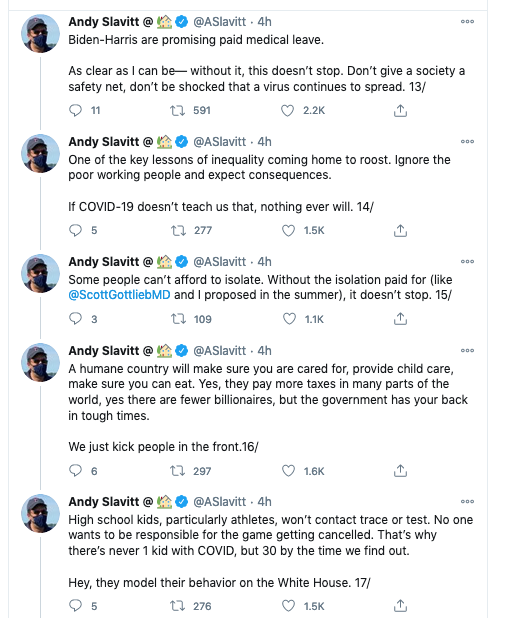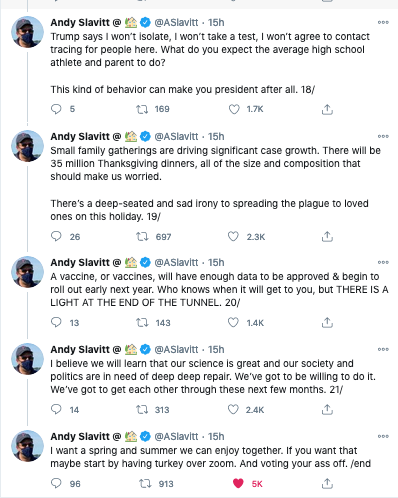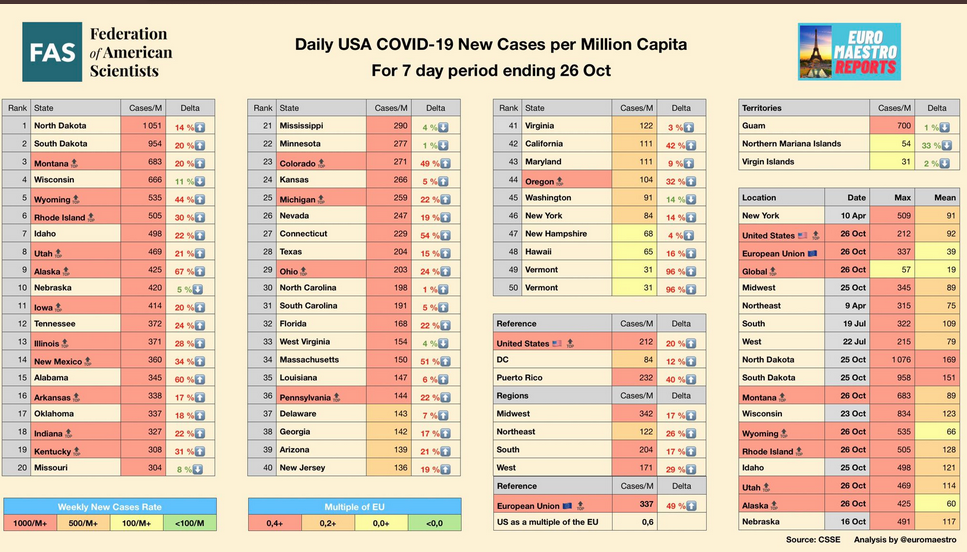The Washington Post deep dive into Scott Atlas is disturbing. The man is a menace to the health of every American, and the Trump regime has entirely given up fighting the coronavirus to embrace a policy of mass-infection.
Given I am one of the vulnerable, I take this personally.
Trump’s den of dissent: Inside the White House task force as coronavirus surges
As summer faded into autumn and the novel coronavirus continued to ravage the nation unabated, Scott Atlas, a neuroradiologist whose commentary on Fox News led President Trump to recruit him to the White House, consolidated his power over the government’s pandemic response.
Atlas shot down attempts to expand testing. He openly feuded with other doctors on the coronavirus task force and succeeded in largely sidelining them. He advanced fringe theories, such as that social distancing and mask-wearing were meaningless and would not have changed the course of the virus in several hard-hit areas. And he advocated allowing infections to spread naturally among most of the population while protecting the most vulnerable and those in nursing homes until the United States reaches herd immunity, which experts say would cause excess deaths, according to three current and former senior administration officials.
Atlas also cultivated Trump’s affection with his public assertions that the pandemic is nearly over, despite death and infection counts showing otherwise, and his willingness to tell the public that a vaccine could be developed before the Nov. 3 election, despite clear indications of a slower timetable.
Atlas’s ascendancy was apparent during a recent Oval Office meeting. After Trump left the room, Atlas startled other aides by walking behind the Resolute Desk and occupying the president’s personal space to keep the meeting going, according to one senior administration official. Atlas called this account “false and laughable.”
Discord on the coronavirus task force has worsened since the arrival in late summer of Atlas, whom colleagues said they regard as ill-informed, manipulative and at times dishonest. As the White House coronavirus response coordinator, Deborah Birx is tasked with collecting and analyzing infection data and compiling charts detailing upticks and other trends. But Atlas routinely has challenged Birx’s analysis and those of other doctors, including Anthony S. Fauci, Centers for Disease Control and Prevention Director Robert Redfield, and Food and Drug Administration Commissioner Stephen Hahn, with what the other doctors considered junk science, according to three senior administration officials.
Birx recently confronted the office of Vice President Pence, who chairs the task force, about the acrimony, according to two people familiar with the meeting. Birx, whose profile and influence has eroded considerably since Atlas’s arrival, told Pence’s office that she does not trust Atlas, does not believe he is giving Trump sound advice and wants him removed from the task force, the two people said.
In one recenet encounter, Pence did not take sides between Atlas and Birx, but rather told them to bring data bolstering their perspectives to the task force and to work out their disagreements themselves, according to two senior administration officials.
The result has been a U.S. response increasingly plagued by distrust, infighting and lethargy, just as experts predict coronavirus cases could surge this winter and deaths could reach 400,000 by year’s end.
This assessment is based on interviews with 41 administration officials, advisers to the president, public health leaders and other people with knowledge of internal government deliberations, some of whom spoke on the condition of anonymity to provide candid assessments or confidential information.
Atlas defended his views and conduct in a series of statements sent through a spokesperson and condemned The Washington Post’s reporting as “another story filled with overt lies and distortions to undermine the President and the expert advice he is being given.”
Atlas said he has always stressed “all appropriate mitigation measures to save lives,” and he responded to accounts of dissent on the task force by saying, “Any policy discussion where data isn’t being challenged isn’t a policy discussion.”
On the issue of herd immunity, Atlas said, “We emphatically deny that the White House, the President, the Administration, or anyone advising the President has pursued or advocated for a wide-open strategy of achieving herd immunity by letting the infection proceed through the community.”
The doctor’s denial conflicts with his previous public and private statements, including his recent endorsement of the “Great Barrington Declaration,” which effectively promotes a herd immunity strategy.
On Saturday, Atlas wrote on Twitter that masks do not work, prompting the social media site to remove the tweet for violating its safety rules for spreading misinformation. Several medical and public health experts flagged the tweet as dangerous misinformation coming from a primary adviser to the president.
“Masks work? NO,” Atlas wrote in the tweet, followed by other misrepresentations about the science behind masks. He linked to an article from the American Institute for Economic Research — a libertarian think tank behind the Barrington effort — that argued against masks and dismissed the threat of the virus as overblown.
Trump and many of his advisers have come to believe that the key to a revived economy and a return to normality is a vaccine.
“They’ve given up on everything else,” said a senior administration official involved in the pandemic response. “It’s too hard of a slog.”
Infectious-disease and other public health experts said the friction inside the White House has impaired the government’s response.
“It seems to me this is policy-based evidence-making rather than evidence-based policymaking,” said Marc Lipsitch, director of the Center for Communicable Disease Dynamics at the Harvard T.H. Chan School of Public Health. “In other words, if your goal is to do nothing, then you create a situation in which it looks okay to do nothing [and] you find some experts to make it complicated.”
These days, the task force is dormant relative to its robust activity earlier in the pandemic. Fauci, Birx, Surgeon General Jerome Adams and other members have confided in others that they are dispirited.
Birx and Fauci have advocated dramatically increasing the nation’s testing capacity, especially as experts anticipate a devastating increase in cases this winter. They have urged the government to use unspent money Congress allocated for testing — which amounts to $9 billion, according to a Democratic Senate appropriations aide — so that anyone who needs to can get a test with results returned quickly.
But Atlas, who is opposed to surveillance testing, has repeatedly quashed these proposals. He has argued that young and healthy people do not need to get tested and that testing resources should be allocated to nursing homes and other vulnerable places, such as prisons and meatpacking plants.
White House spokeswoman Sarah Matthews defended Trump and the administration’s management of the crisis.
“President Trump has always listened to the advice of his top public health experts, who have diverse areas of expertise,” Matthews said in a statement. “The President always puts the well-being of the American people first as evidenced by the many bold, data-driven decisions he has made to save millions of lives. Because of his strong leadership, our country can safely reopen with adequate PPE, treatments, and vaccines developed in record time.”
Yet 10 months into a public health crisis that has claimed the lives of more than 219,000 people in the United States — a far higher death toll than any other nation has reported — a consensus has formed within the administration that some measures to mitigate the spread of the virus may not be worth the trouble.
The president gave voice to this mind-set during an NBC News town hall Thursday night, when he declined to answer whether he supported herd immunity. “The cure cannot be worse than the problem itself,” Trump told host Savannah Guthrie.
But medical experts disagreed, saying it is dangerous for government leaders to advocate herd immunity or oppose interventions.
“We’d be foolish to reenter a situation where we know what to do and we’re not doing it,” said Rochelle Walensky, chief of the division of infectious diseases at Massachusetts General Hospital and a professor of medicine at Harvard Medical School. “This thing can take off. All you need to do is look at what’s happened at 1600 Pennsylvania Avenue over the last two weeks to see that this thing is way faster than we’re giving it credit for.”
‘The cure’
After Trump came home from the hospital this month, he all but promised Americans that they could soon be cured from the coronavirus just as he claimed to have been. In a video taped at the White House on Oct. 5, he vowed, “The vaccines are coming momentarily.”
Then, at a rally last Tuesday night in Johnstown, Pa., Trump told supporters, “The vaccines are coming soon, the therapeutics and, frankly, the cure. All I know is I took something, whatever the hell it was. I felt good very quickly . . . I felt like Superman.”
Trump’s miraculous timeline has run headlong into reality, however. On the same day that he declared “the cure” was near, Johnson & Johnson became the second pharmaceutical giant, after AstraZeneca, to halt its vaccine trial. A third trial, a government-run test of a monoclonal antibody manufactured by Eli Lilly & Co., was also paused. Each move was prompted by safety concerns.
And on Friday, Pfizer said it will not be able to seek an emergency use authorization from the FDA until the third week of November, at the earliest, seemingly making a vaccine before Election Day all but impossible.
Trump’s notion of a vaccine as a cure-all for the pandemic is similarly miraculous, according to medical experts.
“The vaccines, although they’re wonderful, are not going to make the virus magically disappear,” said Tom Frieden, a former CDC director who is president of Resolve to Save Lives. “There’s no fairy-tale ending to this pandemic. We’re going to be dealing with it at least through 2021, and it’s likely to have implications for how we do everything from work to school, even with vaccines.”
Frieden added: “Remember, we have vaccines against the flu, and we still have flu.”
Still, Trump has ratcheted up his push for vaccines over the past several months, intensifying the pressure on government scientists, federal regulators and pharmaceutical executives. He has had one end date in mind: Nov. 3, which is Election Day.
Trump has envisioned a greenlit vaccine as the kind of breakthrough that could persuade voters to see his management of the pandemic as successful and thus upend a race in which virtually all public polls show him trailing Democratic nominee Joe Biden.
Earlier this fall, Trump called Albert Bourla, the chief executive of Pfizer, and asked whether a vaccine could be ready for distribution by late October, before the election. Pfizer spokeswoman Sharon Castillo said executives have regular communications with administration officials on a wide range of health policy issues but that she could not comment on private conversations.
On a call in August with Francis Collins, director of the National Institutes of Health, Trump accused the agency of moving too slowly to approve a vaccine or other treatments, including convalescent plasma, according to two officials familiar with the conversation. The NIH, which declined to comment, is a biomedical research agency and does not approve treatments or vaccines.
Matthews denied that Trump sees the vaccine timetable through the prism of the campaign calendar. “This is not about politics; it’s about saving lives,” she said. She added, “any vaccine approval will maintain the FDA’s gold standard for safety and efficacy and be proven to save lives.”
The relationships between FDA officials and White House staffers have grown more acrimonious since September, when details of stricter FDA vaccine guidance were reported by The Post. Trump and White House Chief of Staff Mark Meadows — who has involved himself in the work of health agencies to a degree other officials consider inappropriate — have repeatedly challenged Hahn over his agency’s proposals and rules, much to the FDA commissioner’s frustration.
Trump is asserting control over the messaging campaign around a vaccine. His politically minded aides in the White House have taken over the government’s communications effort, as opposed to health or scientific communicators at the relevant agencies.
For example, White House aides have sought to persuade Moncef Slaoui, head of “Operation Warp Speed,” the government’s initiative to mass-distribute an eventual vaccine, to speak more positively about the vaccine, and sometimes he has pushed back on their talking points, two officials said.
Trump routinely has told his political advisers that a vaccine would be ready by the time he stands for reelection. And he has plotted with his team on a pre-election promotional campaign to try to convince voters a vaccine is safe, approved and ready for mass distribution — even if none of that is true yet.
These are some of the ingredients of a public health disaster, experts say.
“The one thing you can’t do — and it’s what everybody fears, it’s what the pharmaceutical companies fear, it’s what everybody on the inside fears — is that the government would, because of political purposes or because other countries put a vaccine out before us, truncate the normal process you’d accept for a safe and effective vaccine,” said Paul A. Offit, director of the Vaccine Education Center at Children’s Hospital of Philadelphia, a professor of vaccinology at the University of Pennsylvania and a member of the FDA’s vaccine advisory council.
Trump’s view of the FDA has darkened considerably in recent weeks. The president now believes — despite the absence of any such evidence — that officials there are working against him to slow-walk vaccine approval as “some sort of ‘deep state’ push to keep him from winning reelection,” according to an administration official.
Trump has said as much himself.
“New FDA Rules make it more difficult for them to speed up vaccines for approval before Election Day. Just another political hit job! @SteveFDA,” the president wrote in an Oct. 6 tweet, tagging Hahn’s Twitter handle.
Trump’s conspiratorial view of the FDA is shaped in part by White House trade adviser Peter Navarro and others in the president’s orbit, both inside and outside the government.
Saad B. Omer, director of the Yale Institute for Global Health, said the atmosphere of pressure and recrimination, nurtured by the president, is “very concerning.”
“These are people who have dedicated their lives to working in public health and medicine and research,” he said. “To think that in the biggest public health event of their lives they would sleep an extra hour or slow-walk this for any reason is absurd.”
He added, “It’s like how an ambulance drives faster than a regular car because it’s an emergency, but even an ambulance driver is not foolhardy. They don’t want to drive over the bridge.”
‘A lot of political pressure’
The distrust in Washington has trickled down to the states, where friction has increased between several governors and the administration over the vaccine process.
Some governors and officials close to them privately have expressed alarm about Trump and his aides laying the groundwork for a rushed vaccine announcement. The president has delegated much of the state outreach to Pence, who in regular calls with governors has come across as a smooth salesman for Trump’s speedy approach. The vice president has encouraged governors to help build confidence for eventual vaccines among their constituents.
Illinois Gov. J.B. Pritzker (D), whose state is the site for vaccine trials, said in an interview, “I certainly fear there is a lot of political pressure being applied.” He said his state is preparing for a vaccine rollout, but would carefully evaluate the integrity of any announcement emanating from the White House.
“Nobody has told me that it’ll be ready by November 2nd or anytime before the election,” Pritzker said. “But [Trump] will no doubt claim such a thing because of the cocktail of drugs that he seems to be on now. He’s liable to say anything that isn’t true.”
The concerns are not limited to Democrats. One Republican state official who works with the Trump administration and spoke on the condition of anonymity to preserve that relationship, said, “It’s what I would call soft power. Pence comes on these calls and sounds normal and upbeat, and basically says, ‘Stand with us.’ ”
The official added, “We all want a vaccine, right? We obviously want it. We’ll take it. But we don’t really know if they’ll do this right.”
The politicization of the process has damaged public credibility in an eventual vaccine. A Gallup poll released this month found that 50 percent of Americans said they would be willing to take a coronavirus vaccine approved by the FDA “right now at no cost.” That is a sharp decline from 61 percent in August and 66 percent in July.
During a virtual task force meeting led by Pence on Sept. 21, Washington Gov. Jay Inslee (D) said, “There is a substantial concern,” according to an audio recording of the meeting. “A significant part of that problem is the president’s continued anti-science statements that are contradictory to his medical advisers in so many different ways.”
Inslee asked Pence directly, “Have you discussed with the president how he’s been eroding public confidence in our efforts, including the vaccine approval? Have you discussed that with him? Have you urged him to stop this behavior?”
Pence did not directly answer the question. Rather, he replied, “We think you and all the governors on this call have a great responsibility to make sure the public knows while we’re moving rapidly and while there may be differences in opinion about various events, we just don’t want any undermining of confidence in the vaccine.”
The vice president added, “I can assure you the president will continue to speak clearly about that process.”
Inslee later said in an interview that Pence was anything but assuring.
“There is a pressure campaign,” Inslee said. “We need to follow science and not this distortion campaign . . . The people are on to [Trump]. They know he is trying to turn this into an electoral issue.”
‘A magic dust’
As the election nears, one of Trump’s biggest vulnerabilities with voters is his handling of the pandemic — which he increasingly has sought to blame on others. For instance, the president has complained bitterly about Hahn and Redfield, pointing to congressional testimony and other public comments they have made as undermining his chances for reelection, according to multiple administration officials.
Trump also has vented about the slow pace of vaccine trials and has fumed privately about the pharmaceutical industry, even though he speaks highly of some industry executives. Lately, he has expressed particular concern that the absence of a vaccine announcement has been hurting him with early voting, according to an administration official.
Health and Human Services Secretary Alex Azar, a former Eli Lilly president who has close ties to the pharmaceutical industry, has sought to cool Trump’s temper and assure him that the process is sound.
Also whispering optimism in the tempestuous president’s ear has been Atlas, who is said to be operating with the full confidence of Jared Kushner, Trump’s son-in-law and senior adviser overseeing key aspects of the pandemic response, and Hope Hicks, the president’s counselor and confidante.
This is in part because Atlas has sought to spin the public with what others deride as “happy talk” that the outbreak is close to over. “Everybody looks for what Atlas is giving them,” one official involved in the response said.
Offit said, “This administration, like it does with everything, is overselling vaccines. They make it sound like a magic dust they’ll distribute over the country and the disease will go away . . . What could happen is people think, great, I just got my vaccine, I can throw away my mask, I can engage in high-risk activity, and then we’d actually take a step back.”
Most controversially, Atlas has pushed a baseless theory inside the task force that the U.S. population is close to herd immunity — the point at which enough people become immune to a disease either by becoming infected or getting vaccinated that its spread slows — despite a scientific consensus that the United States is nowhere close.
Given the transmissibility of the coronavirus, experts estimate about 60 to 70 percent of the population would need to become infected to reach herd immunity, a course that they warn would probably result in hundreds of thousands of excess deaths. A recent CDC study, about which Redfield testified to the Senate, showed about 9 percent of people in the United States had antibodies against the virus.
But Atlas publicly contradicted Redfield last month, telling reporters that more of the population was protected against the virus because of so-called T-cell immunity, in which people with exposure to previous coronaviruses — such as the common cold — have T cells that also protect them against covid-19, the disease caused by the novel coronavirus.
No credible scientific study has proved this theory, and Atlas’s advocacy of it dismayed other task force officials.
At a task force meeting late last month, Atlas stated that there was herd immunity in much of the country because of a combination of high infection rates in cities such as New York and Miami and T-cell immunity, according to two senior administration officials. He said that only 40 to 50 percent of people need to be infected to reach the threshold. And he argued that because of this immunity, all restrictions should be lifted, schools should be opened and only the most vulnerable populations, such as nursing home residents, should be sheltered.
This resulted in a fierce debate with Birx and Fauci, who demanded Atlas show them the data that backed up his assertions, one of the officials said.
“It is not the case there’s extra immunity around in T cells,” Lipsitch said. “The vast, vast majority of infectious-disease epidemiologists in this country don’t believe several of the key points these people are arguing for and don’t believe it because the evidence isn’t there and points in the other direction.”
Regardless, Trump has used Atlas to back up his own rejection of medical expertise. At Thursday’s NBC News town hall, a Florida voter asked the president whether after contracting covid-19 he now believed in the importance of mask-wearing.
Trump equivocated.
“I’ve heard many different stories on masks,” he said.
When Guthrie challenged him by noting that all of his health officials were united in advocating masks, Trump countered by invoking Atlas.
“Scott Adkins,” Trump said, mispronouncing the doctor’s name. “If you look at Scott, Dr. Scott, he’s from — great guy — from Stanford, he will tell you.”
“He’s not an infectious-disease expert,” Guthrie said.
“Oh, I don’t know,” Trump replied. “Look, he’s an expert. He’s one of the experts of the world.”

